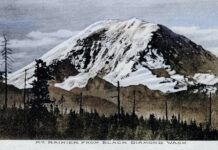Last month, this column featured a photo of civil-defense volunteers adding planking to the Franklin No. 12 mine bridge, which spanned the Green River.
This companion photo by Larry Dion shows the same group of Black Diamond volunteers working on the west side of the river. A story of their efforts appeared in the April 5, 1959 issue of the Seattle Times. They were building approaches so a civil-defense shelter located in an underground coal mine could be used by local residents in case of a nuclear attack.
The inactive mine would provide shelter from radiation in the 3,000-foot horizontal tunnel extending under a hill adjacent to the Enumclaw-Franklin Road. The workers were clearing a trail along the rail tracks to construct a wood walkway down from the mine access road. The path led down to the Green River (seen in the distance) and across the mine bridge.
The three women in the “section gang” to the right of the photo were Patsy Frazier, Joyce Hendrickson and Ruth Henderson.” At the request of Mrs. Frazier, the mine’s owner, Palmer Coking Coal Company had given permission for local defense agencies to store provisions underground. The mine was dry with constant 50-degree temperatures providing suitable storage conditions.
In time Cold War fears subsided and the mine was closed and sealed shut. This photo comes courtesy of JoAnne Matsumura, an Issaquah historical researcher. This coming Saturday, March 4th, the Black Diamond Historical Society highlights the history of Franklin. Please join tour guide, “Mayor” Don Mason for one of his fascinating walks through the old town site.
Meet at the Black Diamond Museum, located at 32627 Railroad Avenue, at 12 p.m. to sign up and hear an orientation. Participants should wear sturdy shoes for this 1.8-mile round trip hike, and dress for the weather as the tour goes on rain or shine.






